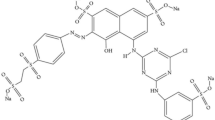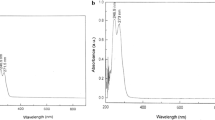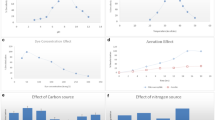Abstract
Printing and dyeing wastewater with high content of organic matters, high colority, and poor biochemical performance is hard to be degraded. In this study, we isolated viable but non-culturable (VBNC) bacteria from printing and dyeing wastewater with the culture media contained resuscitation promoting factor (Rpf) protein secreted by Micrococcus luteus, counted the culturable cells number with the most probable number, sequenced 16S rRNA genes, and performed polymerase chain reaction-denaturing gradient gel electrophoresis. It is obviously that the addition of Rpf in the enrichment culture could promote growth and resuscitation of bacteria in VBNC state to obtain more fastidious bacteria significantly. The identified bacteria were assigned to nine genera in the treatment group, while the two strains of Ochrobactrum anthropi and Microbacterium sp. could not be isolated from the control group. The function of isolated strains was explored and these strains could degrade the dye of Congo red. This study provides a new sight into the further study including the present state, composition, formation mechanism, and recovery mechanism about VBNC bacteria in printing and dyeing wastewater, which would promote to understand bacterial community in printing and dyeing wastewater, and to obtain VBNC bacteria from ecological environment.




Similar content being viewed by others
References
Arulazhagan P, Vasudevan N (2011) Biodegradation of polycyclic aromatic hydrocarbons by a halotolerant bacterial strain Ochrobactrum sp. VA1. Mar Pollut Bull 62:388–394
Ashok BT, Saxena S, Musarrat J (1995) Isolation and characterization of four polycyclic aromatic hydrocarbon degrading bacteria from soil near an oil refinery. Lett Appl Microbiol 21:246–248
Bastiaens L, Springael D, Wattiau P, Harms H, deWachter R, Verachtert H, Diels L (2000) Isolation of adherent polycyclic aromatic hydrocarbon (PAH)-degrading bacteria using PAH-sorbing carriers. Appl Environ Microbiol 66:1834–1843
Chao Y, Mao Y, Wang Z, Zhang T (2015) Diversity and functions of bacterial community in drinking water biofilms revealed by high-throughput sequencing. Sci Rep 5:10044
Colwell RR, Brayton PR, Grimes DJ, Roszak DB, Huq SA, Palmer LM (1985) Viable but non-culturable Vibrio cholerae and related pathogens in the environment–implications for release of genetically engineered microorganisms. Bio-Technol 3:817–820
Daane LL, Harjono I, Zylstra GJ, Haggblom MM (2001) Isolation and characterization of polycyclic aromatic hydrocarbon-degrading bacteria associated with the rhizosphere of salt marsh plants. Appl Environ Microbiol 67:2683–2691
Ding L (2004) Studies on the isolation of viable but non-culturable bacteria and the phylogenetic analysis of the genus Aquaspirillum. The University of Tokyo, Tokyo
Ding L, Su X, Yokota A (2011) Research progress of VBNC bacteria. Acta Microbiol Sin 51:858–862
Ding L, Yokota A (2010) Curvibacter fontana sp. nov., a microaerobic bacteria isolated from well water. J General Appl Microbiol 56:267–271
Ding L, Zhang P, Hong H, Lin H, Yokota A (2012) Cloning and expression of Micrococcus luteus IAM 14879 Rpf and its role in the recovery of the VBNC state in Rhodococcus sp. DS471. Acta microbiol Sin 52:77–82
Durr R, Neumann A, Vielhauer O, Altenbuchner J, Burton SG, Cowan DA, Syldatk C (2008) Genes responsible for hydantoin degradation of a halophilic Ochrobactrum sp G21 and Delftia sp 124 - New insight into relation of D-hydantoinases and dihydropyrimidinases. J Mol Catal B 52–53:2–12
Fegan N, Higgs G, Vanderlinde P, Desmarchelier P (2004) Enumeration of Escherichia coli O157 in cattle faeces using most probable number technique and automated immunomagnetic separation. Lett Appl Microbiol 38:56–59
Felsenstein J (1985) Confidence limits on phylogenies: an approach using the bootstrap. Evol Int J org Evol 39:783–791
Ghai R, Rodriguez-Valera F, McMahon KD, Toyama D, Rinke R, Cristina Souza de Oliveira T, Wagner Garcia J, Pellon de Miranda F, Henrique-Silva F (2011) Metagenomics of the water column in the pristine upper course of the Amazon river. PLoS ONE 6:e23785
Hett EC, Rubin EJ (2008) Bacterial growth and cell division: a mycobacterial perspective. Microbiol Mol Biol R 72:126–156
Huang JP, Swain AK, Thacker RW, Ravindra R, Andersen DT, Bej AK (2013) Bacterial diversity of the rock-water interface in an East Antarctic freshwater ecosystem, Lake Tawani(P)dagger. Aquat Biosyst 9:4
Kilic NK (2009) Enhancement of phenol biodegradation by Ochrobactrum sp isolated from industrial wastewaters. Int Biodeter Biodegr 63:778–781
Kumar P, Prasad B, Mishra IM, Chand S (2008) Decolorization and COD reduction of dyeing wastewater from a cotton textile mill using thermolysis and coagulation. J Hazard Mater 153:635–645
Kumar SS, Kumar MS, Siddavattam D, Karegoudar TB (2012) Generation of continuous packed bed reactor with PVA-alginate blend immobilized Ochrobactrum sp DGVK1 cells for effective removal of N, N-dimethylformamide from industrial effluents. J Hazard Mater 199:58–63
Liao M, Zhang HJ, Xie XM (2009) Isolation and identification of degradation bacteria Enterobacter aerogenes for pyrethriods pesticide residues and its degradation characteristics. Huan jing ke xue = Huanjing kexue 30:2445–2451
Magurran AE (1998) Ecological diversity and its measurement. Princeton University Press, Princeton
Martini MC, Albicoro FJ, Nour E, Schluter A, van Elsas JD, Springael D, Smalla K, Pistorio M, Lagares A, Del Papa MF (2015) Characterization of a collection of plasmid-containing bacteria isolated from an on-farm biopurification system used for pesticide removal. Plasmid 80:16–23
Mukamolova GV, Kaprelyants AS, Young DI, Young M, Kell DB (1998) A bacterial cytokine. Proc Natl Acad Sci USA 95:8916–8921
Oliver JD (2010) Recent findings on the viable but nonculturable state in pathogenic bacteria. FEMS Microbiol Rev 34:415–425
Pinto D, Santos MA, Chambel L (2015) Thirty years of viable but nonculturable state research: unsolved molecular mechanisms. Crit Rev Microbiol 41:61–76
Serpaggi V, Remize F, Recorbet G, Gaudot-Dumas E, Sequeira-Le Grand A, Alexandre H (2012) Characterization of the “viable but nonculturable” (VBNC) state in the wine spoilage yeast Brettanomyces. Food Microbiol 30:438–447
Shannon CE, Weaver W (1963) The mathematical theory of communication. University of Illinois Press, Champaign
Su XM, Chen X, Hu JX, Shen CF, Ding LX (2013) Exploring the potential environmental functions of viable but non-culturable bacteria. World J Microbiol Biotechnol 29:2213–2218
Su XM, Shen H, Yao XY, Ding LX, Yu CN, Shen CF (2013) A novel approach to stimulate the biphenyl-degrading potential of bacterial community from PCBs-contaminated soil of e-waste recycling sites. Bioresour Technol 146:27–34
Su XM, Shen XY, Ding LX, Yokota A (2012) Study on the flocculability of the Arthrobacter sp., an actinomycete resuscitated from the VBNC state. World J Microbiol Biotechnol 28:91–97
Wei YM, Wang JQ, Liu, TT, Kong WW, Chen N, He XQ, Jin Y (2015) Bacterial communities of Beijing surface waters as revealed by 454 pyrosequencing of the 16S rRNA gene. Environ Sci Poll Res Int 22:12605–12614
Weidner S, Arnold W, Puhler A (1996) Diversity of uncultured microorganisms associated with the seagrass Halophila stipulacea estimated by restriction fragment length polymorphism analysis of PCR-amplified 16S rRNA genes. Appl Environ Microbiol 62:766–771
Wu HF, Wang SH, Kong HL, Liu TT, Xia MF (2007) Performance of combined process of anoxic baffled reactor-biological contact oxidation treating printing and dyeing wastewater. Bioresour Technol 98:1501–1504
Wu XL, Liang RX, Dai QY, Jin DC, Wang YY, Chao WL (2010) Complete degradation of di-n-octyl phthalate by biochemical cooperation between Gordonia sp strain JDC-2 and Arthrobacter sp strain JDC-32 isolated from activated sludge. J Hazard Mater 176:262–268
Wu YR, He TT, Zhong MQ, Zhang YL, Li EM, Huang TW, Hu Z (2009) Isolation of marine benzo[a]pyrene-degrading Ochrobactrum sp BAP5 and proteins characterization. J Environ Sci-China 21:1446–1451
Xu HS, Roberts N, Singleton FL, Attwell RW, Grimes DJ, and Colwell RR (1982) Survival and viability of nonculturable Escherichia coli and Vibrio cholerae in the estuarine and marine-environment. Microb Ecol 8:313–323
Ye Q, Liu J, Du J, Zhang J (2015) Bacterial diversity in submarine groundwater along the coasts of the yellow sea. Front Microbiol 6:1519
Acknowledgements
This research was supported by the Zhejiang Provincial Public Welfare Technology Applied Research Project (2017C33046), Zhejiang Provincial Natural Science Foundation of China (LY13C010002), Shenzhen Basic Research Project (JCYJ20140417113430641, JCYJ20140509174140691 and JCYJ20140417113430732), Foundation of Shenzhen Strategic Emerging Industries Development (JSKF20150831171545604) and Shenzhen Technology development Project (CXZZ20150529144041624).
Author information
Authors and Affiliations
Corresponding authors
Ethics declarations
Conflict of interest
We declare that we do not have any commercial or associative interest that represents a conflict of interest in connection with the work submitted.
Rights and permissions
About this article
Cite this article
Jin, Y., Gan, G., Yu, X. et al. Isolation of Viable but Non-culturable Bacteria from Printing and Dyeing Wastewater Bioreactor Based on Resuscitation Promoting Factor. Curr Microbiol 74, 787–797 (2017). https://doi.org/10.1007/s00284-017-1240-z
Received:
Accepted:
Published:
Issue Date:
DOI: https://doi.org/10.1007/s00284-017-1240-z




